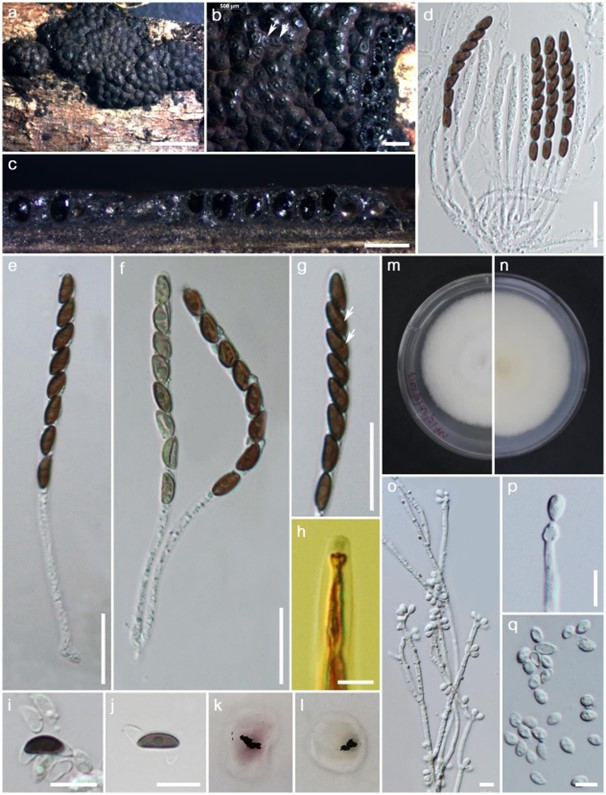Hypomontagnella monticulosa (Mont.) Sir, L. Wendt & C. Lambert, Mycol. Progr. 18: 190 (2018) [2019]
Index Fungorum number: IF 827252; Facesoffungi number: FoF 06781
Saprobic on dead branch of Leucaena leucocephala. Sexual morph: Stromata effused-pulvinate, with conspicuous to inconspicuous perithecial mounds, surface blackish, woody to carbonaceous tissue immediately beneath surface and between perithecia surface and perithecia, have KOH-extractable light purple pigments. Perithecia sphaerical to obovoid, ostioles higher than the stromatal surface. Asci 85–110 × 4.5–6.5 μm (x̅ = 97.5 × 5.4 μm, n = 25), 8-spored, cylindrical, with J+, discoid apical ring. Ascospores 7.5–9.3 × 3–4.5 μm (x̅ = 8.3 × 3.7 μm, n = 30), light brown to brown, unicellular, ellipsoid-inequilateral, with broadly to less frequently narrowly rounded ends, with straight germ slit spore-length on convex side; perispore eventually dehiscent in 10% KOH, epispore smooth. Asexual morph: Conidiophores in culture, mononematous, hyaline to olivaceous green or pale brown, roughened, usually with virgariella-like branching patterns. Conidiogenous cells 16.5–24 × 1.4–2.2 μm (x̅ = 20.1 × 1.8 μm, n = 20), polyblastic, sympodial, terminal, later becoming intercalary, finely denticulate, hyaline, smooth to finely roughened. Conidia 3–4.7 × 2–3 μm (x̅ = 3.9 × 2.5 μm, n = 25), ellipsoid, hyaline, smooth to finely roughened.
Culture characteristics – Colonies on PDA reaching 30.5 mm diam. after 14 days at 25 ºC, covering petri dish in 4 weeks, initially white, circular, flat, slightly wooly, entire margin. Sporulating regions at the centre.
Material examined – Thailand, Naan, Doi Phu Kha, dead branch of Leucaena leucocephala (Fabaceae), 4 August 2017, MC. Samarakoon SAMC007, MFLU 18–0822, HKAS 102355, living culture MFLUCC 18–0362.
GenBank number – ITS: MN337231, LSU: MN336235, RPB2: MN366246, β-TUB: MN509783.
Known distribution (based on molecular data) – Argentina (Sir et al. 2016b), Brazil (unpublished), French Guiana (Wendt et al. 2018), French Polynesia (Lambert et al. 2019), Indonesia (unpublished), Malaysia (Zainee et al. 2018), South Korea (unpublished), Thailand (Okane et al. 2008, Daranagama et al. 2015, this study), USA (Stadler et al. 2008, U’Ren et al. 2016).
Known hosts (based on molecular data) – Cladonia leporina (U’Ren et al. 2016), Euterpe precatoria (unpublished), Leucaena leucocephala (this study). Lichen (unpublished), Sargassum seaweed (Zainee et al. 2018), Zingiber griffithii (unpublished).
Notes – This species has a circumtropical distribution and is frequently encountered in the rainforests of Africa, Asia and Latin America. Our specimen shares the characteristic features of stromata with conical papillate ostioles, encircled by superficial black discs that are typical of the genus and the microscopic features are in agreement with Hypomontagnella monticulosa. The comparisons of the basepairs of ITS show 0.7 % differences (4/555 bp) and both RPB2 and β-TUB are also highly similar. In our ITS, LSU, RPB2 and β-TUB based combined analyses reveal that our strain clusters with Hypomontagnella monticulosa (MUCL 54604) with high statistical support (100% ML). Surup et al. (2014) described H. monticulosa from Thailand and this is the first known record of the occurrence of Hypomontagnella monticulosa on Leucaena leucocephala.

Figure 1 – Hypomontagnella monticulosa (Material examined – THAILAND, Naan, Doi Phu Kha, dead branch of Leucaena leucocephala (Fabaceae), 04 August 2017, MC. Samarakoon SAMC007, MFLU 18-0822, HKAS 102355, living culture MFLUCC 18-0362). a Mature stroma on bark. b Stromatal surface showing papillate and ostiolar discs (indicated by white arrows). c Stromata in vertical section. d-f Asci. g Ascospores (sigmoid germ slits indicated by white arrows). h Ascus tip in Lugol’s reagent. i, j Perispores. k, l KOH-extractable pigments. m Surface of colony. n Reverse of colony. o-q Conidiophores and conidia. Scale bars: a = 2 mm, b, c = 500 μm, d-g = 20 μm, i, j = 10 μm, o-q = 5 μm.
